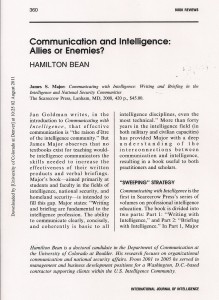
Hamilton Bean, “Communication and Intelligence: Allies or Enemies?,” International Journal of Intelligence and Counterintelligence Vol 22 No 2 March 2009 pp 360-365
I will not replicate all that is at www.oss.net and to a much lesser extent, www.earth-intelligence.net, but do want to recognize a handful of extraordinary individuals by isolating their especially meritorious contributiions to the long-running debate about national intelligence reform and re-invention.
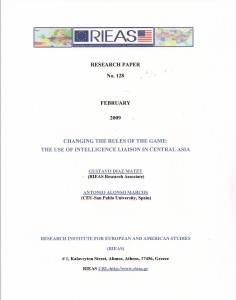
Gustavo Diaz Matey, Antonio Alonso Marcos
1. Central Asia as a regional system
2. The common perception of threats as the first step to cooperating in matters of intelligence
3. The struggle for regional leadership: Kazakhstan and Uzbekistan
4. Three weak actors: Kyrgyzstan, Tajikistan, Turkmenistan
5. Three great powers interested in the zone
6. Multi-vector diplomacy and games of alliances
7. The Western viewpoint: the problems of alliance with non-democratic States
Conclusion: Toward the conception of intelligence services as a democratic indicator
Below is a very important report that focuses primarily on Congress as a consumer of SECRET information. The report has yet to be written on Congressional needs for decision-support (intelligence) that is unclassified and can be shared with constituents, the press, and the private sector being regulated and taxed.
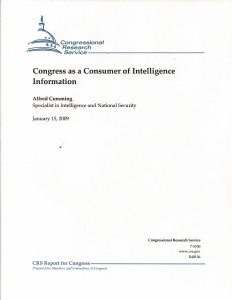
Click on the Frog to see a one-page listing of Congressional committees and how they would benefit from an Open Source Agency (OSA) that included Congress via the Congressional Research Service (CRS) as a primary stake-holder and recipient of unclassified decision-support. Conressional needs are also addressed by The Smart Nation Act: Public Intelligence in the Public Interest.

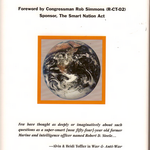
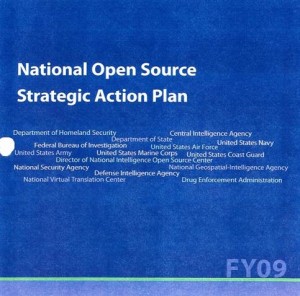
1. Needs to be redone and reissued without Doug Naquin’s signature. The delegation of authority to him is in violation of both ICD 300 and ICD 301.
2. The Vision is flawed because it focused only on security. Whole of Government needs for OSINT span the full range of ten high-level threats to humanity and the twelve core policies that need to be harmonized, listed below to demonstrate the paucity of the CIA OSC version of vision.
High-Level Threats to Humanity: 01 Poverty;02 Infectious Disease;03 Environmental Degradation;04 Inter-State; 05 Civil War; 06 Genocide; 07 Other Atrocities; 08 Proliferation; 09 Terrorism; 10) Transnational Crime.
Twelve Core Policies for Harmonization: 01 Agriculture; 02 Diplomacy; 03 Economy; 04 Education; 05 Energy; 06 Family; 07 Health; 08 Immigration; 09 Juctice; 10 Security; 11 Society; 12 Water.
Any Open Source Officer (OSO) who cannot recide these from memory and relate them to the mission of the US National Intelligence Community as outlined in the National Intelligence Strategy, should be assigned to less-demanding administrative duties.
The above can be used in conjunction with Secretary Gates’ statement that the military cannot do it all, and the Defense Science Board studies (all available at www.phibetaiota.net under References/DSB), to make the case for OSINT being a “360 degree” service that must meet the Mission Area needs of all of the elements of the Federal, State, and Local governments as well as regional constellations of mixed government and non-governmental organizations focused on challenges of common concern, e.g. Darfur, piracy, etcetera.
The illustration on page 5 is severely flawed in that it fails to integrate the OSINT needs and capabilities of all the federal non-security consumers at the same time that it assumes Homeland Security Enterprise will cover the non-security aspects of information sharing, and it ignores the Rest of the World both domestic and international.
The illustration on page 7 is severely flawed—a historic tendency of FBIS/OCS in that it assumes all OSINT is accessible via technical means. Humans and direct face to face interaction with Humans, is not part of the FBIS/OSC understanding.
The objectives on page 8 are laudable and not achievable as the IC OSINT enterprise is now organized and led. The integrated linguist activity is a particularly urgent need that is not understood nor properly defined in terms of online and human capabilities that could be harnessed.